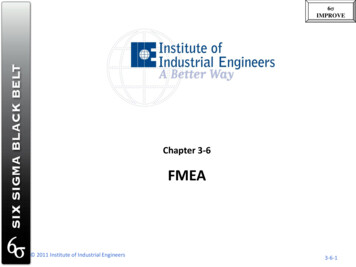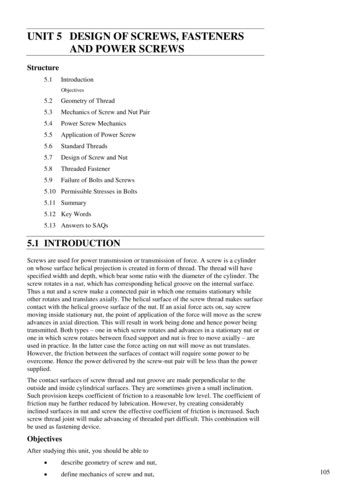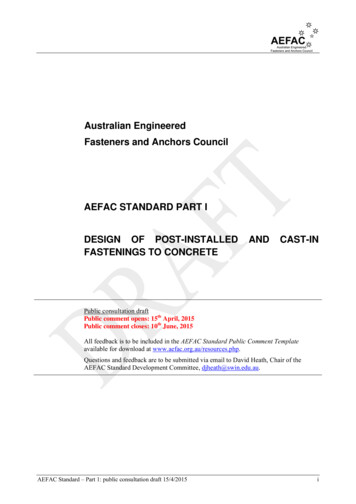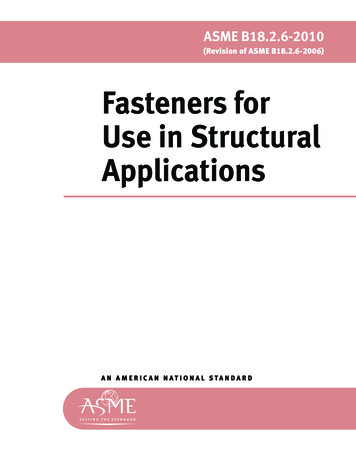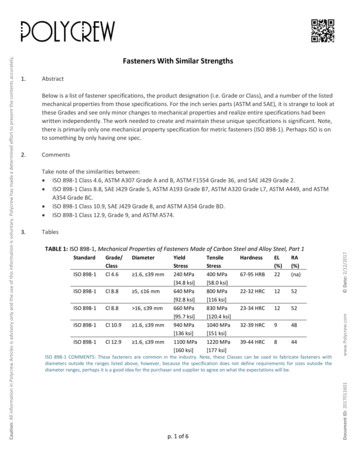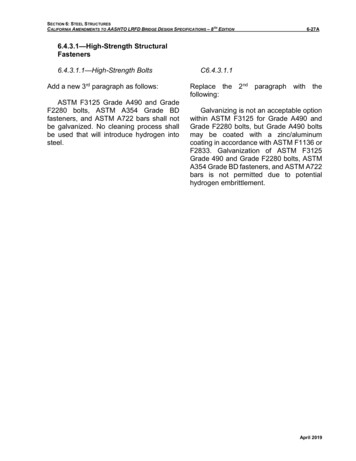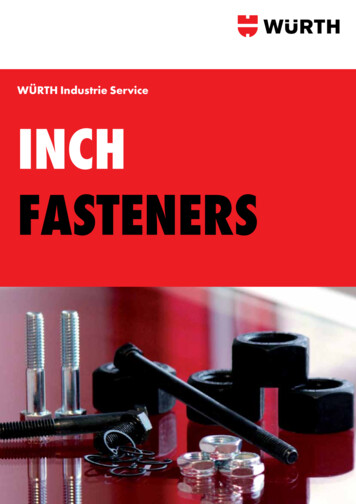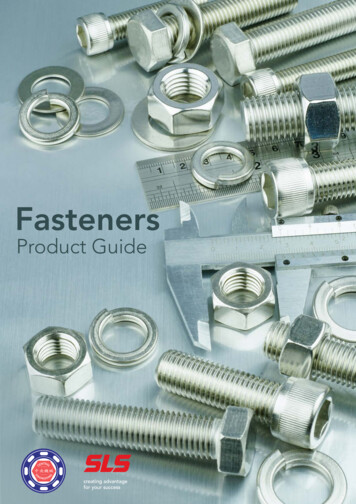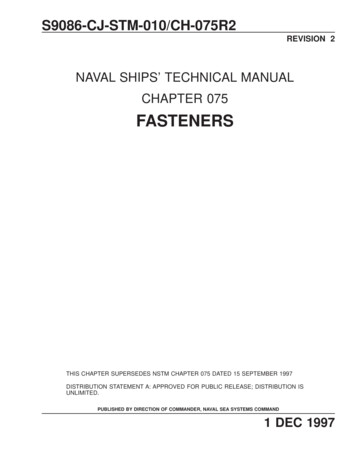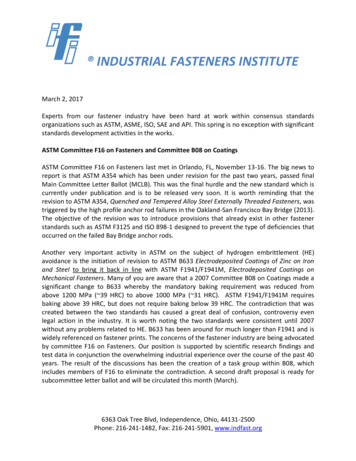
Transcription
INDUSTRIAL FASTENERS INSTITUTEMarch 2, 2017Experts from our fastener industry have been hard at work within consensus standardsorganizations such as ASTM, ASME, ISO, SAE and API. This spring is no exception with significantstandards development activities in the works.ASTM Committee F16 on Fasteners and Committee B08 on CoatingsASTM Committee F16 on Fasteners last met in Orlando, FL, November 13-16. The big news toreport is that ASTM A354 which has been under revision for the past two years, passed finalMain Committee Letter Ballot (MCLB). This was the final hurdle and the new standard which iscurrently under publication and is to be released very soon. It is worth reminding that therevision to ASTM A354, Quenched and Tempered Alloy Steel Externally Threaded Fasteners, wastriggered by the high profile anchor rod failures in the Oakland-San Francisco Bay Bridge (2013).The objective of the revision was to introduce provisions that already exist in other fastenerstandards such as ASTM F3125 and ISO 898-1 designed to prevent the type of deficiencies thatoccurred on the failed Bay Bridge anchor rods.Another very important activity in ASTM on the subject of hydrogen embrittlement (HE)avoidance is the initiation of revision to ASTM B633 Electrodeposited Coatings of Zinc on Ironand Steel to bring it back in line with ASTM F1941/F1941M, Electrodeposited Coatings onMechanical Fasteners. Many of you are aware that a 2007 Committee B08 on Coatings made asignificant change to B633 whereby the mandatory baking requirement was reduced fromabove 1200 MPa ( 39 HRC) to above 1000 MPa ( 31 HRC). ASTM F1941/F1941M requiresbaking above 39 HRC, but does not require baking below 39 HRC. The contradiction that wascreated between the two standards has caused a great deal of confusion, controversy evenlegal action in the industry. It is worth noting the two standards were consistent until 2007without any problems related to HE. B633 has been around for much longer than F1941 and iswidely referenced on fastener prints. The concerns of the fastener industry are being advocatedby committee F16 on Fasteners. Our position is supported by scientific research findings andtest data in conjunction the overwhelming industrial experience over the course of the past 40years. The result of the discussions has been the creation of a task group within B08, whichincludes members of F16 to eliminate the contradiction. A second draft proposal is ready forsubcommittee letter ballot and will be circulated this month (March).6363 Oak Tree Blvd, Independence, Ohio, 44131-2500Phone: 216-241-1482, Fax: 216-241-5901, www.indfast.org
The next meetings of ASTM Committees F16, A01 and B08 will take place in Toronto, the weekof May 8, 2017.ISO/TC 2 – Technical Committee on FastenersISO Committee TC 2 on Fasteners met in Shanghai, China, October 17-21. North America wasrepresented by two excellent delegations from USA and Canada. A number of importantstandards are under revision. One of the most important is ISO 4042, Electroplated Coatings.The current ISO 4042:1999 has undergone as many as 21 revision drafts over the course of 4years. From a North American perspective, we have ensured that ISO 4042 and ASTMF1941/F1941M will be consistent in their requirements, especially regarding avoidance ofhydrogen embrittlement. ISO 4042 Committee Draft (CD) was moved to Draft InternationalStandard (DIS) stage. This is a significant step forward! Final technical revisions will be madebefore moving to Final Draft International Standard (FDIS) stage and then onto publication. Atthe current pace, we expect the document to be published in 2018, a full 19 years since the lastrevision!Another very important document that is nearing publication is a technical report, ISO TR20491, titled Fundamentals of Fastener Hydrogen Embrittlement. After two years of verycareful review by the national committees and several revisions within TC 2/SC 14Subcommittee on Coatings, the technical report has reached the stage of final editorial review.We expect ISO TR 2049 to be published in the middle of 2017.(Note: the ISO technical report is based on a white paper by the same that is available for freeon the IFI website p.)The next plenary meeting of ISO TC 2 will take place the week of October 16 in Berlin, with adhoc group activities leading up to the plenary meetingSubsea Bolting Task GroupIn December, 2012, a Chevron offshore oil rig lower marine riser package separated from theblowout preventer, releasing a small amount of synthetic drilling fluids into the Gulf of Mexico.The incident was the result of the failure of H4 connector bolts. The Bureau of Safety andEnvironmental Enforcement (BSEE) issued a Safety Alert which triggered immediate measuresby the offshore oil and gas industry, notably the replacement of H4 connector bolts worldwide.Although, the root cause of the failures was never determined, initial analysis report mistakenlyascribed the cause to Internal Hydrogen Embrittlement (IHE). This error has caused a great dealof confusion in the industry. A similar but separate occurrence in 2014 has given rise to fearsthat the problem is pervasive and has made headlines in the Wall Street Journal.2
A public “Bolting Forum” held by BSEE held in Washington, DC on August 29 was intended tooutline the actions being taken to address the issue. For example, earlier this year, BSEE askedthe American Petroleum Institute Subcommittee 21 on Materials (API SC21) to makerecommendations to prevent any future occurrence of such a failure. API SC 21 Task Group onMulti-Segment Bolting in Subsea Applications was created as a result of the BSEE request. Thetask group (TG) includes a broad range of experts from the fastener and oil and gas industries.The mandate of the task group is to conduct research and testing aimed and to propose datadriven recommendations to improve Oil & Gas industry standards and practices relative tobolting. More precisely, the TG will be examining the selection of fastener materials and theselection of coatings. The proposals will eventually result in changes to the API Specification20E, Alloy and Carbon Steel Bolting for Use in the Petroleum and Natural Gas Industries. I willkeep our industry informed as the work progresses.Salim BrahimiIFI Director of Engineering Technologysbrahimi@indfast.org***3
STANDARDS REVISION COMPLETED IN THE PAST YEARASTM Committee F16 – Fasteners ASTM F836M-16 - Standard Specification for Style 1 Stainless Steel Metric Nuts (Metric) ASTM F837M-16 - Standard Specification for Stainless Steel Socket Head Cap Screws[Metric] ASTM F879M-16 - Standard Specification for Stainless Steel Socket Button and FlatCountersunk Head Cap Screws (Metric) ASTM F1554-15e1 - Standard Specification for Anchor Bolts, Steel, 36, 55, and 105-ksiYield StrengthSee recent article on the publication of this standard on the AISC el/archives/2016/01/something.pdf ASTM F2832-11(2016) - Standard Guide for Accelerated Corrosion Testing forMechanical FastenersASTM F3043-15 - Standard Specification for “Twist Off” Type Tension Control StructuralBolt/Nut/Washer Assemblies, Alloy Steel, Heat Treated, 200 ksi Minimum TensileStrengthASTM F3111-16 - Standard Specification for Heavy Hex Structural Bolt/Nut/WasherAssemblies, Alloy Steel, Heat Treated, 200 ksi Minimum Tensile StrengthASTM F3125/F3125M-15a - Standard Specification for High Strength Structural Bolts,Steel and Alloy Steel, Heat Treated, 120 ksi (830 MPa) and 150 ksi (1040 MPa) MinimumTensile Strength, Inch and Metric DimensionsSee recent article on the publication of this standard on the ASTM potlight/aligned-and-combinedma15.html ASTM F3148-15 - Standard Specification for High Strength Structural Bolt Assemblies,Steel and Alloy Steel, Heat Treated, 144ksi Minimum Tensile Strength, Inch DimensionsASTM Committee A01 – Steel – (SC A01.22 Bolting Materials) ASTM A193/A193M-16 Standard Specification for Alloy-Steel and Stainless Steel Boltingfor High Temperature or High Pressure Service and Other Special Purpose Applications ASTM A194/A194M-16 Standard Specification for Carbon Steel, Alloy Steel, andStainless Steel Nuts for Bolts for High Pressure or High Temperature Service, or Both ASTM A320/A320M-15a Standard Specification for Alloy-Steel and Stainless SteelBolting for Low-Temperature Service ASTM A962/A962M-16a Standard Specification for Common Requirements for BoltingIntended for Use at Any Temperature from Cryogenic to the Creep Range4
ASME Committee B1 – Screw Threads ASME B1.16M – 2016 - Gages and Gaging for Metric M Screw ThreadsASME Committee B18 – Fasteners ASME B18.1.1 – 2016 - Small Solid Rivets ASME B18.1.2 – 2016 - Large Rivets ASME B18.1.3M – 2016 - Metric Small Solid Rivets ASME B18.10 – 2016 - Track Bolts and Nuts ASME B18.31.1M – 2016 - Metric Continuous and Double End Studs ASME B18.24 - 2015 – Fastener Part Identification Numbering SystemISO Committee TC2 – Fastener ISO 2320:2015 Fasteners-Prevailing torque steel nuts-Functional propertiesSAE Committee – Fasteners SAE J773 Conical Spring WashersAug 31, 2016 StabilizedA FEW NOTABLE STANDARDS IN THE REVISION PROCESS ASME B18.2.1, Bolts and Cap Screws (inch series).ASME B18.2.6, Structural Fasteners (inch series).ASTM A354, Standard Specification for Quenched and Tempered Alloy Steel Bolts,Studs, and Other Externally Threaded Fasteners. PASSED FINAL BALLOT!ASTM F606/F606M, Standard Test Methods for Determining the Mechanical Propertiesof Externally and Internally Threaded Fasteners, Washers, Direct Tension Indicators, andRivets.ASTM F2282 Quality Assurance Requirements for Carbon and Alloy Steel Wire, Rods,and Bars for Mechanical Fasteners.ASTM B633 Electrodeposited Coatings of Zinc on Iron and SteelISO 4042 Fasteners – Electroplating – moved from CD to DIS stageISO 3269 Fastener - acceptance - WD stageISO 15330 Fasteners - Preloading test for the detection of hydrogen embrittlement Parallel bearing surface method – WD stageISO/TR 20491 Fundamentals of Hydrogen Embrittlement in Steel Fasteners.UNDEGOING FINAL EDITORIAL REVISIONSalim BrahimiIFI Director of Engineering Technologysbrahimi@indfast.org5
avoidance is the initiation of revision to ASTM B633 Electrodeposited Coatings of Zinc on Iron and Steel to bring it back in line with ASTM F1941/F1941M, Electrodeposited Coatings on Mechanical Fasteners. Many of you are aware that a 2007 Committee B08 on Coatings made a significant change to B633 whereby the mandatory baking requirement was reduced from above 1200 MPa ( 39 HRC) to
